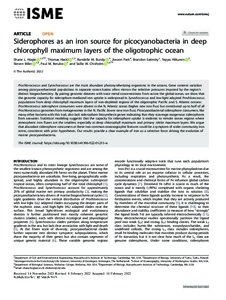Siderophores as an iron source for picocyanobacteria in deep chlorophyll maximum layers of the oligotrophic ocean
Satinsky Brandon; Park Jiwoon; Hogle Shane L.; Berube Paul M.; Hiltunen Teppo; Chisholm Sallie W.; Hackl Thomas; Biller Steven; Bundy Randelle M.
https://urn.fi/URN:NBN:fi-fe2022081153785
Tiivistelmä
Prochlorococcus and Synechococcus are the most abundant photosynthesizing organisms in the oceans. Gene content variation among picocyanobacterial populations in separate ocean basins often mirrors the selective pressures imposed by the region’s distinct biogeochemistry. By pairing genomic datasets with trace metal concentrations from across the global ocean, we show that the genomic capacity for siderophore-mediated iron uptake is widespread in Synechococcus and low-light adapted Prochlorococcus populations from deep chlorophyll maximum layers of iron-depleted regions of the oligotrophic Pacific and S. Atlantic oceans: Prochlorococcus siderophore consumers were absent in the N. Atlantic ocean (higher new iron flux) but constituted up to half of all Prochlorococcus genomes from metagenomes in the N. Pacific (lower new iron flux). Picocyanobacterial siderophore consumers, like many other bacteria with this trait, also lack siderophore biosynthesis genes indicating that they scavenge exogenous siderophores from seawater. Statistical modeling suggests that the capacity for siderophore uptake is endemic to remote ocean regions where atmospheric iron fluxes are the smallest, especially at deep chlorophyll maximum and primary nitrite maximum layers. We argue that abundant siderophore consumers at these two common oceanographic features could be a symptom of wider community iron stress, consistent with prior hypotheses. Our results provide a clear example of iron as a selective force driving the evolution of marine picocyanobacteria.
Kokoelmat
- Rinnakkaistallenteet [19207]
